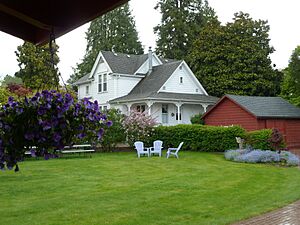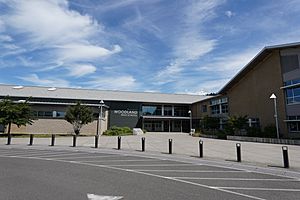Woodland, Washington facts for kids
Quick facts for kids
Woodland, Washington
|
|
|---|---|

Cedar Creek Grist Mill
|
|
| Country | United States |
| State | Washington |
| Counties | Cowlitz, Clark |
| Area | |
| • Total | 4.25 sq mi (11.02 km2) |
| • Land | 4.11 sq mi (10.65 km2) |
| • Water | 0.14 sq mi (0.37 km2) |
| Elevation | 30 ft (9 m) |
| Population
(2020)
|
|
| • Total | 6,531 |
| • Density | 1,579.52/sq mi (609.78/km2) |
| Time zone | UTC-8 (Pacific (PST)) |
| • Summer (DST) | UTC-7 (PDT) |
| ZIP code |
98674
|
| Area code(s) | 360 |
| FIPS code | 53-79625 |
| GNIS feature ID | 2412301 |
Woodland is a city in Washington state, located mostly in Cowlitz County. A smaller part is in Clark County. It is part of the Longview, Washington area. In 2020, about 6,531 people lived there.
Contents
What's in the Name?
Woodland got its name because of its many trees. Christopher Columbus Bozarth, the city's first shop owner and postmaster, named it. His wife suggested the name. Other small communities in Washington also share similar names because of their wooded areas.
A Look at Woodland's Past
Early Settlers and Farms
In 1849, a man named Adolphous Le Lewes started a farm near the Lewis River. The river is actually named after him, not Meriwether Lewis!
Soon after, two families from Iowa, the Strongs and the Bozarths, moved to the area. Squire Bozarth built the first wooden house, calling it "Woodland Farm House." His son, Christopher Columbus Bozarth (C.C.), later opened a store. This store was named "Woodland" after his father's farm. The city of Woodland grew up around this store.
Pekin: The First Trading Spot
Before Woodland, there was a trading center called Pekin. It had a store and a post office by 1868. But Pekin was built on stilts because it flooded almost every June. Woodland was on higher ground and more central. So, Woodland soon became the main trading spot.
A Moment in History: The 1856 Event
On March 26, 1856, there was a single recorded event involving some members of the Yakima tribe. They came to the area, but a Cowlitz tribe member, Indian Zack, warned the settlers. The settlers safely moved to a block house in St. Helens until the Yakima people returned to the east. A monument to Indian Zack once stood at Horseshoe Lake Park.
Growing into a City
Woodland was officially planned out on October 14, 1889. This was the same year Washington became a state. The community officially became a city on March 27, 1906. L. Hopf was the first mayor.
In 1907, the city started its first sewer system and got telephone service. Steamboats like the Alarm and the Lucy Mason stopped daily. There was also train service. In 1913, a bridge was built over the Lewis River. Before that, people used a ferry. The bridges for Interstate 5 and the dike around Horseshoe Lake were started in 1940. The Woodland Fire Department began in 1925.
Major Floods
Woodland has faced big floods. In 1948, "Old Town Woodland" was hit hard. Another large flood happened in 1996, affecting the northeast part of the city. President Bill Clinton even visited Woodland during the 1996 flood.
Hulda Klager: The Lilac Lady
Woodland is famous for Hulda Klager (1863–1960). She was known as the "Lilac Lady" because she grew many new kinds of lilacs. Hulda came to America from Germany when she was two. Her family bought a farm in Woodland.
She loved flowers and learned to create new types of plants. She made new kinds of roses, dahlias, apples, and especially lilacs. By 1920, her garden was so beautiful that she opened it to visitors every spring during "Lilac Week."
In 1948, a flood destroyed her garden. But people from all over the Northwest sent her starts of her lilacs from their own gardens. By 1950, at 87 years old, Hulda opened her garden again for Lilac Week. After she passed away in 1960, a local garden club saved her garden. They bought it and made it a state and national historic site.
Where is Woodland?
Woodland covers about 3.48 square miles (9.01 square kilometers). Most of this area is land, with a small part being water.
What's the Weather Like?
Woodland has a warm-summer Mediterranean climate. This means summers are warm and dry, but not too hot. The average monthly temperatures do not go above 71.6°F (22°C).
Who Lives in Woodland?
| Historical population | |||
|---|---|---|---|
| Census | Pop. | %± | |
| 1910 | 384 | — | |
| 1920 | 521 | 35.7% | |
| 1930 | 1,094 | 110.0% | |
| 1940 | 980 | −10.4% | |
| 1950 | 1,292 | 31.8% | |
| 1960 | 1,336 | 3.4% | |
| 1970 | 1,622 | 21.4% | |
| 1980 | 2,341 | 44.3% | |
| 1990 | 2,500 | 6.8% | |
| 2000 | 3,780 | 51.2% | |
| 2010 | 5,509 | 45.7% | |
| 2020 | 6,531 | 18.6% | |
| U.S. Decennial Census 2020 Census |
|||
Population in 2010
In 2010, there were 5,509 people living in Woodland. There were 1,965 households. About 41.8% of households had children under 18. The average household had 2.77 people.
The average age in the city was 32.9 years. About 29.8% of residents were under 18. About 12.3% were 65 or older. The population was almost evenly split between males (48.8%) and females (51.2%).
Fun Things to Do
Planter's Days Festival
Planter's Days is a big festival in Woodland. It started in 1922 and is the longest-running community festival in Washington state. It celebrates the dikes built along the Columbia and Lewis Rivers. These dikes help prevent yearly floods.
The festival lasts four days. It includes a parade, a Firefighters' BBQ, a Frog Jump, and amusement rides at Horseshoe Lake Park. There is also a car show on the last day.
Cedar Creek Grist Mill
The city is also close to the Cedar Creek Grist Mill. This old mill is a National Historic Landmark. It is a cool place to visit and learn about history.
Learning in Woodland
Woodland Public Schools runs the public schools in the city. This includes Woodland High School. As of 2019, about 2,487 students attend schools in the district. There is one high school, one middle school, and three elementary schools. The elementary schools are Columbia, North Fork, and Yale.
See also
 In Spanish: Woodland (Washington) para niños
In Spanish: Woodland (Washington) para niños



